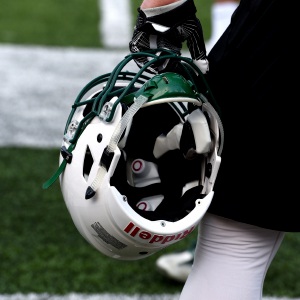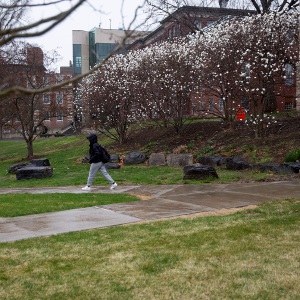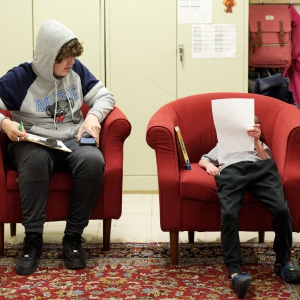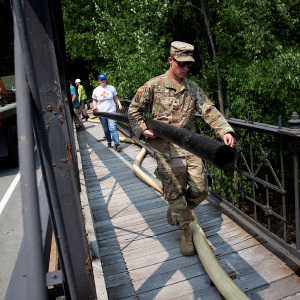Newbury Man Honors Vermont Hunting Legacy
| Published: 09-17-2017 12:47 AM |
Newbury, Vt.
With this year’s bear season a week old, Spear eases out of his driveway and heads out into the dim wet morning, the ledge above the dashboard of his truck cluttered with binoculars, dog collars, a Gatorade bottle filled with straight black tea, and the .44 Magnum he’s used to kill several bears over the past 13 years. He hunts bear three or four times a week. Today, he’d like to shoot a nice 400-pounder, which would be a real prize. But he’s not sure if he’ll get it.
“If it was ‘shoot a bear every time you go out,’ it would be called shooting, not hunting. This is hunting.”
Spear, 65 and three years retired from carpentry, speaks with the consciously woodsy drawl that serves as a currency among those sportsmen who prize experience and authenticity over the proper grammar of those who don’t know the first thing about bear hounds.
“I don’t like shock collars, but they have their job,” he says, pointing to a few on the dashboard. “A lot of people misuse them. They don’t like it when I say, ‘Stop usin’ it or you’re wearin’ it.’ I’ve done that more than once.”
Spear looks like a white-whiskered lumberjack, with broad shoulders, a powerful torso and two calloused slabs of hands that grip the steering wheel as he drives slowly down an ever-narrowing series of Newbury’s back roads. The truck bed is filled with a wooden box that Spear made out of scrap plywood. He cut holes into the sides so that the four dogs in the back can see — and smell — the moist landscape rolling by.
“This is all about the dogs,” Spear says. “If you like hounds, like dogs — it’s all about the dogs.”
2004
One April, 13 years ago, when Spear attended his first meeting of the Vermont Bear Hound Association on the invitation of a new friend, he said he’d like to get into the sport himself.
Article continues after...
Yesterday's Most Read Articles
 Football helmet maker buys Lebanon’s Simbex
Football helmet maker buys Lebanon’s Simbex
 James Parker granted parole for his role in Dartmouth professors’ stabbing deaths
James Parker granted parole for his role in Dartmouth professors’ stabbing deaths
 Zantop daughter: ‘I wish James' family the best and hope that they are able to heal’
Zantop daughter: ‘I wish James' family the best and hope that they are able to heal’
 Kenyon: Dartmouth alumni join union-busting effort
Kenyon: Dartmouth alumni join union-busting effort
 Parker up for parole more than 2 decades after Dartmouth professor stabbing deaths
Parker up for parole more than 2 decades after Dartmouth professor stabbing deaths
 Through new school partnerships, CRREL seeks to educate young scientists
Through new school partnerships, CRREL seeks to educate young scientists
“One of the old boys asked me, ‘what kind of dog are you running?’ ”
“Well, if I had my preferences, I’d run black and tans,” Spear replied.
He thought it was a reasonable answer at the time. He’d had black and tans since he was 9, and used them to hunt rabbits and raccoons. He’d heard a good coonhound can be trained to become a good bear hound. The old-timer didn’t think so. He was a bluetick man, himself.
“Well, he burst out laughing. ‘There ain’t no such thing as black and tan bear hounds.’ ”
Spear, riled, shot back.
“Well, there will be,” he said.
It was a face-saving boast, but the truth was, Spear didn’t really have any idea of how to make good on it. The laughter stung, he says. “Made me feel kind of stupid.”
2017
When the dogs start barking, Spear stops the truck and cocks an ear, replaying the exact sequence and tenor of each yip and growl in his mind.
“At times my black dog, my big black dog back there, he might bark coyote track.” Spear pronounces coyote with two syllables. “It’s just a little bit of a, little different bark. And the little female, she didn’t really wind up where I wanted her to be.”
To understand the nuances of each individual dog is part of the skill of bear hunting, Spear says. He knows a large segment of the public is critical of the activity, and that much of the criticism is driven by a belief that the bear doesn’t have a sporting chance to escape. But he’s chased plenty of bears that he’s never been able to lay eyes on.
He says the bears employ a certain amount of craftiness when trying to evade dogs. Some walk up a stream, or backtrack their own trail and then jump aside, to lead the dogs to a dead-end. Others will climb one tree, jump to another and then climb back down. He’s got a video of himself and a friend rescuing a dog from a high ledge after a bear evaded the pack by scrambling over a ridgetop.
After another moment’s deliberation, Spear decides the barks don’t add up to a hot bear scent.
“I’m not going to waste time on that.”
He puts the truck back into gear, and starts rolling forward again.
2004-2007
In the months after boasting that he would bring Vermont its first black and tan bear hounds, Spear set himself to learning everything he could about the sport. Black and tans were hard to come by, so he bought what he could from the area’s stock of blueticks, Walkers, beagles and Plotts. It was brutal. The dogs would begin baying, and he would set them loose and chase after them in the woods, listening for a sign that the bear had been treed.
“They would run, run, run, and I wouldn’t see what they were running. It wouldn’t tree,” he said.
He wasted a whole season, and advice was scant.
“Bear hunters are territorial and secretive,” he says.
Spear kept trying, and kept failing. He saw two bears in his first three years. Finally, someone threw him a bone.
“One guy finally told me, if an animal can’t climb a tree, you’re not going to tree it,” he says. Spear’s undisciplined dogs had been chasing deer and coyotes. He got discriminating, looking for bear tracks, or fresh piles of dung before chasing into the woods. He tried to teach the dogs that, of all the scents in the forest, only one merited a chase: Bear.
2017
Spear’s truck approaches a very rough spot in the road, so rock-studded it looks more like a stream bed. Before him, the surface is hidden beneath a mud puddle the size of a mattress. He drives into the water without hesitation. That boldness doesn’t always pay off. Once, when he faced a similar situation at the edge of West Fairlee, the truck rocked to the side and water began pouring in along the door seam.
“I had two come-alongs, probably 80 feet of chain back there. A couple straps. It took me an hour,” he says. “But I got myself out.”
He’s seen a 350-pound bear in the area, before the season began. If a 400-pounder doesn’t present itself, that might be worth shooting, he allows.
Forrest Hammond, the lead bear biologist with the Vermont Department of Fish and Wildlife, said during a telephone interview last week that there are about 90 resident houndsmen like Spear operating in the state, which maintains a bear population of about 5,000. In 2016, hunters killed 697 bears in the state — including 46 in Orange County and 76 in Windsor County — and dogs were used in 85 of those kills.
However, because hounds tree a bear first, hunters using dogs can be more discriminating in what they choose to shoot, which explains why eight of the 15 heaviest bears taken in Vermont in 2016 were killed with the aid of dogs, including a 346-pounder in Newbury. Hammond said the common practice of treeing, but not killing, a bear helps to instill a healthy sense of fear in the animals.
“We feel it’s just another way of hunting in the state,” Hammond said. “Culturally, people have always hunted with hounds. The very first settlers, they probably all had hunting dogs. It’s part of our legacy.”
Regulations governing bear hunting with hounds will likely be updated again on Wednesday, when the Vermont Fish and Wildlife Board is scheduled to vote on a variety of rule changes in Montpelier. One proposed change would prevent New Hampshire bear hound hunters from hunting in Vermont until two weeks after the September season begins. The change is in response to a request from the Vermont Bear Hound Association to shut New Hampshire hunters out altogether. New Hampshire does not allow Vermonters to use hounds to hunt bears in their state.
2008
One day, when it was raining out, Spear stood on the front stoop of one of the longtime association members and appealed for help.
“How’s chancin’, maybe once in a while, once a month or something, we could get together and I’d run a couple dogs with your dogs,” he asked.
The response was not what he’d hoped.
“ ‘Well, Butchie Boy’ — he always called me Butchie Boy — he says, ‘I don’t make a habit of helping other people train their cull dogs.’ ”
“Cull dogs.” It was a cutting insult. Dogs of such poor quality that they would be culled from a population of healthy animals in order to improve the breeding stock.
“Well, two of them were dogs I got from him,” Spear says. The conversation grew heated, in an understated Yankee way.
“I want you to mark it on your calendar that I said this today,” he told the man. “I will have hounds. I will have hounds that run and tree bears, and I will train them myself, and I won’t be out spending five, ten thousand dollars a year on dog, buyin’ ’em just to have ’em die.”
Insult had been returned. The man had recently bought three dogs at $5,000 apiece, only to see one die within a month and another run over by a car soon after. Spear stalked back to his truck.
2017
Spear pulls up alongside a man who’s driven down from Cabot with his own pack of bear hounds barking from the truck bed.
“What’s happening?” Spear asks.
“We’re trying,” the Cabot man replies.
“Well, we’re trying,” Spear says. “You get any hits this morning?”
“A little bit,” says the Cabot man. “But I — who the hell knows how long he was here, with all this water. Any strikes?”
“I haven’t hit them at all,” Spear answers. “I ain’t sayin’ there ain’t bear around. You hit any of the cornfield?”
“Yeah,” the Cabot man says. “There was a little scent there.”
The man’s tone seems to indicate that it’s not worth Spear’s trouble. But as soon as he drives off, Spear backtracks the truck.
“You never know,” he says. “He don’t know how good my dogs are, and I don’t know how good his dogs are.”
Spear drives toward the cornfield. Walking through a wet cornfield will drench a person, he says. But there could be bear. In the right circumstances, he says, he might shoot a bear even if it weighed only 300 pounds.
2008-2012
For years, every time Spear saw the man he had quarreled with, the question was the same.
“How you doin’, Butchie Boy?”
“Pretty good,” Spear might reply. By now, he was learning how to track bear, and listen to his dogs. “I seen two bears runnin’.”
The man always responded the same way, drawing his laconic response out.
“Gooooood.”
2017
Bear hound injuries are another focal point for opponents of the practice. As Spear drives, it’s clear that within his sportsman culture, the dogs are considered working animals, rather than pets, a dramatically different mindset. He recalls a hunting friend’s pair of dogs, which had a reputation for “grit” — the determination to face down a bear that was reluctant to tree.
“Him and his brother would stretch a bear, grab a 100-, 150-pound bear from either side, grab it and just hold it. They were gritty dogs,” Spear said.
Spear’s friend announced one day that he intended to accept an offer for the dog.
“He was gonna’ sell it, was gonna’ get 2,500 bucks for it. Guy was gonna’ come down Sunday. We went out huntin’ Saturday. Three dogs got left in the woods overnight, got on an ugly bear.”
Some of the dogs came back to the hunters, injured, but three of them — including the two gritty littermates— wouldn’t come back.
“Found him the next morning,” Spear says. “That dog had a broken leg, broken pelvis, all chewed up. And it cost him 2,500 with the vet. So there’s a $5,000 swing from where it could have gone.”
Spear says he admires those dogs, but wouldn’t want to own them.
“Gritty ones are the ones that cost you the money. Mine are OK gritty. But they’re smart enough to stay back just about that much further,” he says, holding his hands 8 inches apart.
2013-2014
Spear connected with a Danville man who had a litter of black and tans. He spent $300 on one, Moses, and soon was prepping the puppy by dragging an old bearskin around a training pen. The following summer, Moses went out with some of the senior dogs and was let loose on a hot trail. Moses went about 500 yards, and then came back to the truck, tail wagging apologetically.
“Either the dogs outran him, or he just lost interest,” Spear said. But he was encouraged. “When they come back by themselves, you know they can use their nose.”
The second time out, Moses went a little further. And the third time, he stayed out all day, tracking with the others. When he returned from the woods, Spear saw he had been injured. Spear never saw the bear, but he was still excited. He took a photo of the wound — an unmistakable claw mark — and printed it out on his home printer.
“I started, just print out a picture, take it to the meetin’ and throw it on the table. Not say a word, you know. It’s proof he’d seen a bear.”
2017
Spear is not sure which of the large network of roads around the cornfield the other hunter traveled. He starts driving up a grass lane, corn on one side, woods on the other. The dogs begin to howl again. This time, Lil Girl has sounded. Spear stops the truck, piqued and doubtful at the same time.
“She had me interested, but the way the big dog was barkin’. Choppin’. When it’s a bear, he’ll rrrrrl,” Spear imitates the more fluid baying that he associates with the dogs scenting a bear. He decides to test the water, heading to the back of the track and lifts Lil Girl from the truck tailgate down to the ground, snapping a short lead onto her collar. He lets her lead him into the grass. She squats and relieves herself.
“If there was a hot bear track right there, she’d already be barking,” he says, disapprovingly. He gets back in the truck.
A steady patter starts on the windshield, and Spear starts driving reluctantly back along the road, headed for lunch with his wife, Diana Spear, back home. It doesn’t always end like this. Spear talks about a 150-pound bear that resisted the dogs’ best efforts to tree it.
“Cross the road in front of us, dogs were already on him. Tried to catch the dogs off and couldn’t,” Spear says. “Finally, he had enough dogs bleedin’, I decided he needed to die.”
Spear pointed to his toes to describe how close the bear was.
“When I killed him, his head bounced off the ground and landed on my foot,” he says. “If he climbed a tree, that bear would have lived that day.”
The biggest bear he ever shot weighed about 290, he admits.
2015-2017
Moses is now a full-fledged bear hound, and he’s not the only black and tan Spear has trained.
These days, Spear sees 30 bears a year, more than many experienced hunters. He can make it look pretty easy — if the dogs’ training holds, and if they pick up the right track, and if they chase down a bear, and if that bear heads up a tree, and if that tree is somewhere that can be accessed on foot.
When all goes right, Spear often has his camera handy. And he often indulges his desire to throw a picture down on the table of the association meeting, without comment.
“Black and tan dog treeing on a bear,” he says.
“A picture.”
Their response is quiet. And that suits Spear. He’s now the association president.
“You know,” he says “just they don’t razz me anymore.”
Matt Hongoltz-Hetling can be reached at mhonghet@vnews.com or 603-727-3211.

 Some families find freedom with Newport microschool
Some families find freedom with Newport microschool Woodstock Aqueduct Company seeks to double water rates
Woodstock Aqueduct Company seeks to double water rates
